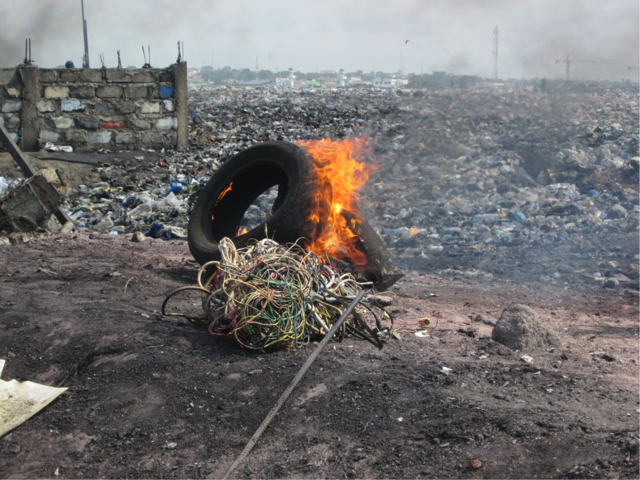Peter C. Little, Department of Anthropology, Rhode Island College
Agbogbloshie is ablaze.
Featured image: Getting ready to burn a bundle of wires. Photo Credit: Peter Little
For scholars and activists engaged in global environmental politics of high-tech rubbish, Agbogbloshie is a familiar name. A scrap site in Accra, Ghana, Agbogbloshie has attracted numerous international environmental NGOs, engineers, environmental health scientists, slum tourists, journalists, photographers, and social scientists.
Most visitors witness what they have been told about this place. Agbogbloshie is ablaze. It is a toxic postcolonial zone of intense metal recovery, a site where the burning of discarded electronic and electrical devices (DEEDs) to recover valuable metals, especially copper and aluminum, is an everyday activity. It is space of electronics toxicity, an environment of lead, mercury, cadmium, PVC, and plastics containing brominated flames retardants that present health and environmental risks (Caravanos et al 2011; Feldt et al 2014). Agbogbloshie is also a place of contentious green NGO intervention that seeks to “eliminate” burning of electronics by migrant laborers who make up the majority of workers in the scrap site. In many ways, this is a place and space not only of controversial e-waste, but also a location of vibrant and toxic electronic “pyropolitics” (Marder 2015).
…what ethnographic research is revealing is the front-and-center significance of the micropolitics of fire, ignition, burning, and NGO intervention.
I have spent the last two summers in Agbogbloshie conducting ethnographic research. Supported by research grants from Rhode Island College and the Wenner-Gren Foundation for Anthropological Research, my project aims to better understand how these e-waste workers understand their environment, labor, health, and futures in a toxic postcolonial context where multiple forms of social and environmental injustice endure. This is the general focus, but what ethnographic research is revealing is the front-and-center significance of the micropolitics of fire, ignition, burning, and NGO intervention.
Like other visitors to the site, it is common to find workers burning bundles of copper wires to remove the plastic insulation. The primary fuel source for the fires includes junked tires, insulation from refrigerators, and any petrochemical product that ignites. These wire bundles range in size and are worth between 8 and 10 Ghana cedi (roughly between $2.00 and $2.50), though metal market values directly impact local copper prices. It takes workers about 10-15 minutes to burn off all the plastic insulation. The copper wire is then bagged and sold to scrap metal dealers, usually Nigerians, who then sell the copper for export in Tema, the planned industrial port of Accra, which is about 20 miles east of the city center.
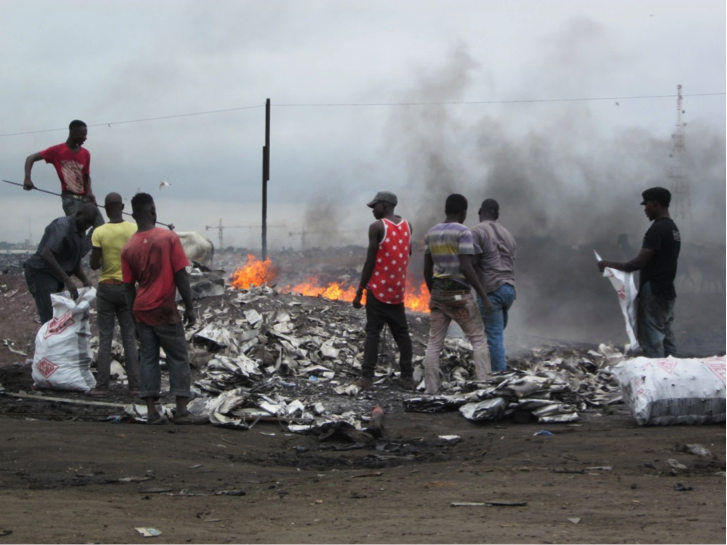
Workers breaking down their aluminum scrap. Photo Credit: Peter Little
Aluminum is another sought after metal in this landscape of DEEDs. Once heated and broken down, sheets of aluminum are packed tightly into large white bags (see photo above). In the summer of 2016, aluminum was selling for 1.7 Ghana Cedi (about 40 cents) per pound. A full bag weighs about 25-30 pounds, so they make about $10-12 per bag, but observe how many workers there are, which means the profits are distributed among the workers.
According to a Basel Convention report on e-waste in Africa, “in the informal collection and recycling of e-waste, daily revenues vary greatly from between US$ 0.22 and US$ 9.50. This income has, in most cases, to be shared with other family members and is only earned on economically active days and not during periods of sickness or other emergencies. Therefore, it is concluded that a significant segment of e-waste workers in Nigeria and Ghana live below the internationally defined poverty line of US$ 1.25 per day.” (Basel Convention Report, 2011). The distribution of cash is highly structured, meaning some workers receive more than others, depending on many things: how long they have been working in Agbogbloshie, their social ties and connections with local chiefs or chiefs in their villages in the north that have close kin working in the scrap yard, or whether they have a wife and/or children.
Also, recent social science research finds that workers who run the scales are notorious for taking their cut or manipulating their scales, which again further diminishes the actual value of the bag of aluminum or copper collected (Akese 2014).
The primary mission: “Eliminate Burning at Agbogbloshie.”
In 2014, Agbogbloshie became the site of a “model” e-waste recycling center built to make e-waste recycling work safer and more environmentally friendly. The primary mission: “Eliminate Burning at Agbogbloshie.” With support from a variety of government and nongovernment agencies, the new recycling facility, recently named the Agbogbloshie Recycling Center (ARC) has a clear risk reduction goal. In short, the new facility aims to reduce the health risks of electronic cable burning —only one of many sources of air pollution in Agbogbloshie—by using automated machines to strip coated cables and wires of various sizes containing copper and other valuable, yet toxic, materials.
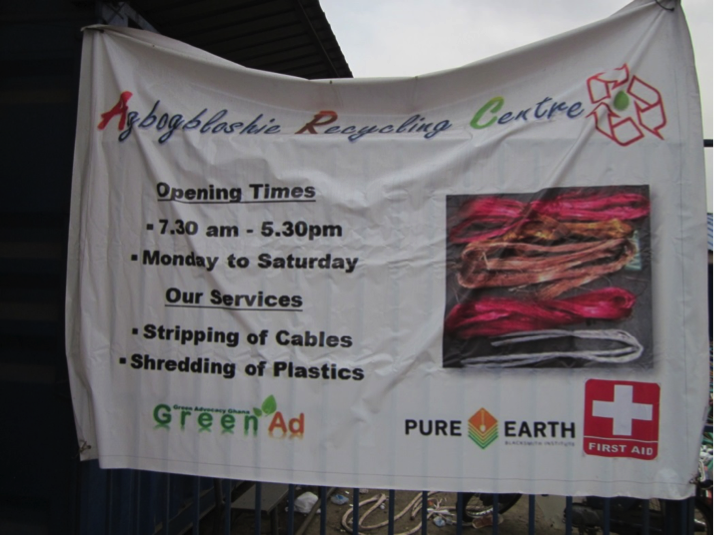
The Agbogboloshie Recycling Center sign. Photo Credit: Peter Little.
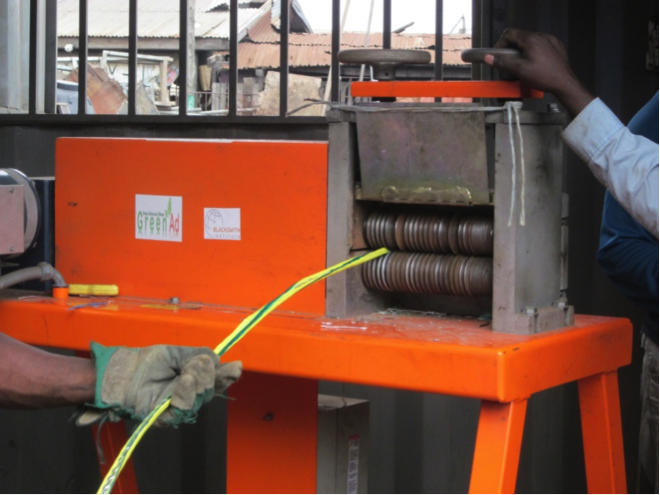
The granulator in action. Photo Credit: Peter Little
This is one of several cable stripping machines, also known as granulators, used at the ARC. Pure Earth/Blacksmiths organization has helped train six workers to use the granulators who, when a shipment of wires arrives, feed the cables through the machines to separate the plastic insulation from the valuable aluminum (see above photo). The NGOs supporting the use of these granulators include Green Advocacy Ghana and the Pure Earth organization (formerly Blacksmiths Institute) which is a solutions-based international environmental NGO that targets the most polluted or toxic places on Earth.
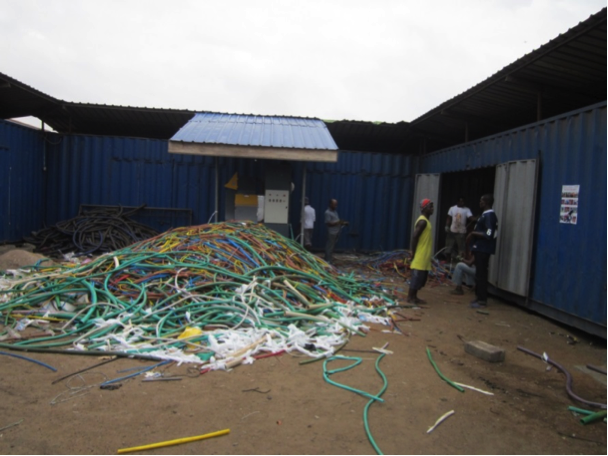
Plastic discard from the e-waste granulator. Photo Credit: Peter Little
Most, if not all, of the cables received by the ARC are large diameter electrical cables from either Ghana’s electrical utility company or from neighboring countries. These larger cables contain valuable aluminum. For example, the shipment pictured above came from Burkina Faso, likely from the primary electrical company, the Societe Nationale d’Electricite Du Burkina. The bundles of wires that the burners have access to and burn are obviously much smaller in diameter and are coming from small household electronics made up of largely copper wiring.
The ARC amounts to a pyropolitical project fueled by “techno-optimism.” The NGOs supporting this risk reduction mission are strong promoters of this optimism, but how this optimism registers among workers in Agboglboshie is more difficult to know. As anthropologist Damien Drooney observes in his study of medical science and technology facilities in Ghana:
“Techno-optimism is taken as a stance toward technological innovation where new technology tends to be perceived as a good thing. By approaching this attitude from a location in Ghana, we can better understand some of the cultural features of contemporary techno-optimism and the stakes involved. Places like Silicon Valley are characterized by boundless, blinding optimism that sometimes seems like an unshakable faith in the inevitable (and profitable) unfolding of technological progress as an inherent good. But this is not limited to California; places like Ghana are a part of this same culture of techno-optimism” (Drooney 2015:224).
The cable stripping machines may raise the level of market optimism, but most everyone I have interviewed is a bit more skeptical of the idea that these technologies will meet the environmental health goals that helped justify their installment and use in Agbogbloshie in the first place.
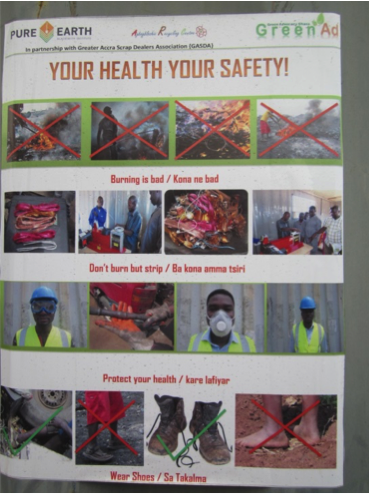
Communicating Risk and Risk Mitigation. Photo Credit: Peter Little
To burn is to be bad, even if burning e-waste to extract copper is done simply to make a living.
Risk communication signs now line the walls of the ARC facility. These signs (pictured above), contain pictures of “good” and “bad” practices, things workers should either avoid or do. Translated into Dagbani, the primary language of workers, the risk communication message is straight forward: “Burning is bad,” Don’t burn but strip,” “Protect your health,” and “Wear shoes.” Continuing to burn is considered an act of ignorant destruction. To burn is to be bad, even if burning e-waste to extract copper is done simply to make a living.
But Pure Earth and their partners involved in the ARC are overlooking several front-and-center matters of fact that the burners are dealing with: 1) small diameter electronic wires are the most common wires burners deal with and the granulator can’t process them; 2) even with the recent installment of a new granulator that can feed small diameter wires, the bundle and tangle of wires burners deal with would require extra time to untangle and feed through the machine, time that could be spent simply burning; 3) it is unclear what the charge is to use granulators, since it costs money to power the machines to do this “greener” e-waste recycling.
There is a large cascade of questions that could be raised about the actual efficacy and sustainability of the ARC, but what is certain is that the burners will continue doing their work autonomously and will do so until they see how the ARC has a direct benefit to them. These are just some of the ground-level politics informing the management of “rubbish electronics” (Lepawsky et al 2014) in Agbogbloshie and I am sure more electronic pyropolitics and NGO friction are on the horizon.
References
Akese, Grace Abena. 2014. Price Realization for Electronic Waste (e-waste) in Accra, Ghana. MA Thesis, Department of Geography, Memorial University of Newfoundland.
Caravanos, Jack et al. 2011. “Assessing Worker and Environmental Chemical Exposure Risks at an e-Waste Recycling and Disposal Site in Accra, Ghana.” Journal of Health and Pollution 1(1):16-25.
Droney, Damien. 2014. “Ironies of Laboratory Work during Ghana’s Second Age of Optimism.” Cultural Anthropology 29(2):363-384.
Feldt, T. et al. 2014. “High levels of PAH-metabolites in urine of e-waste recycling workers from Agbogbloshie, Ghana.” Science of the Total Environment 466:369-376.
Lepawsky, Josh et al. 2014. “Composing Urban Orders from Rubbish Electronics: Cityness and the Site Multiple.” International Journal of Urban and Regional Research 39(2):185-199.
